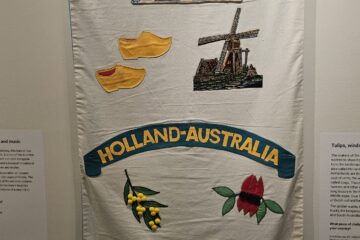(We are interested in further details and corrections on the personal info mentioned in this article).
Ernst van Hattum was a Dutch-Australian artist who was born on January 29, 1923, in Nijmegen, the Netherlands. He studied at the Academy of Fine Arts in Arnhem, Netherlands from 1940 to 1942, before serving in the Dutch army during World War II.
In 1953, van Hattum immigrated to Australia with his wife and two children, settling in Mildura, Victoria. He was appointed as the director of the Mildura Art Gallery in 1958. In 1961 he set up the 1st Mildura Sculpture Prize. In his own words the aim was to achieve “a professional presentation of a range of contemporary sculptural works by established sculptors to commissioning agents “. It enabled the Mildura Art Gallery to distinguish itself within the hierarchy of the regional galleries network in Victoria. It made Mildura the national centre of sculpture. (One of the participants was the Dutch Sculptor Berend van de Struik)
Ernst resigned in 1965 when the following statement was made:
He was instrumental in organising the first Australian sculpture contest ever held and its presentation in 1961 in Mildura was hailed by art circles throughout Australia and overseas. A second successful sculpture contest was held here in 1964.
He was a great supporter of the the £193,000 Arts Centre with a new art gallery and 400 seat little theatre modelled on ideas Mr van Hattum brought back from a special overseas tour. (Mildura Art Gallery)
The Ernst van Hattum Art Gallery in Mildura is named in his honour and is dedicated to showcasing the work of local and regional artists.
Ernst also worked as a commercial artist and designer for local firms and began exhibiting his paintings in the 1960s. He soon became known for his striking landscapes and seascapes, which were often inspired by the Australian outback and coastline.
Van Hattum’s work is characterised by his bold use of color and his ability to capture the light and atmosphere of the Australian landscape. He was particularly interested in the effects of sunlight on the natural environment, and his paintings often feature dramatic contrasts between light and shadow.
See also:
- “Ernst van Hattum: Sculpture,” exhibition catalogue published by Macquarie Galleries, Sydney, in 1975
- “Ernst van Hattum: Sculpture,” monograph by Neville Drury, published by Craftsman House, Sydney, in 1995
- “Ernst van Hattum: Sculptor,” article by Sasha Grishin, published in “Art and Australia,” vol. 24, no. 2, 1986
- “Ernst van Hattum: The Art of Place and Time,” article by Anne Virgo, published in “Art Monthly Australia,” no. 91, 1996


